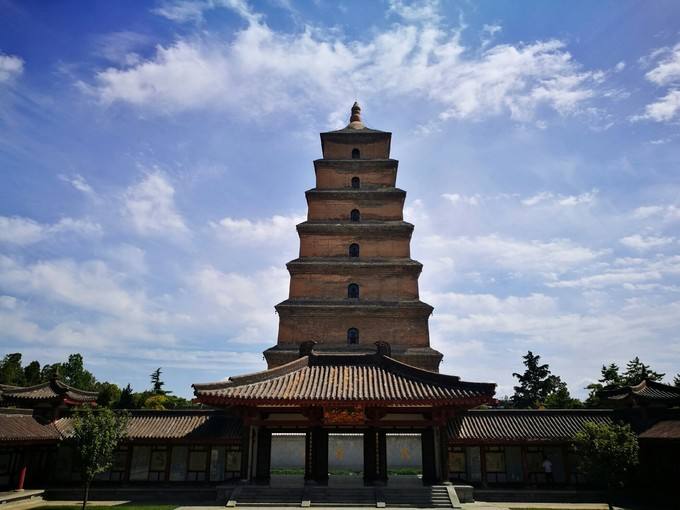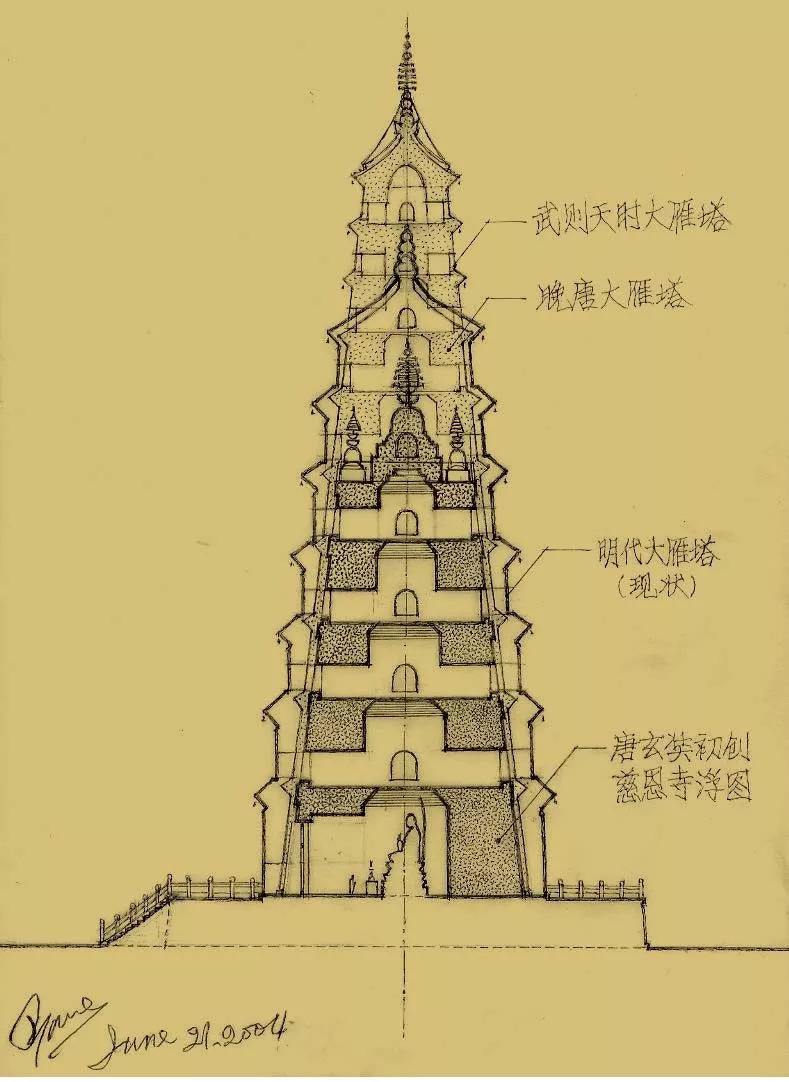
当前课程知识点:陕西导游英语 > 1. 美景篇 > 1.6 The Big Wild Goose Pagoda 西安大雁塔 > 1.6 Text 讲解词


Good morning, ladies and gentlemen. As a 4A attraction, the Big Wild Goose Pagoda is always a popular travel destination. Today we are going to appreciate its charm. Now please come to the introduction.
Daci’en Temple
The Big Wild Goose Pagoda stands in Daci’en Temple in the south of Xi’an city . It is one of the most famous pagodas in China. Daci’en Temple was originally built in 589 AD in the Sui Dynasty, and was named Wulou Temple. In 648AD, Emperor Li Zhi (Gao Zong), then still a crown prince, ordered to repair the temple. Emperor Li Zhi was a filial son. He had this temple renovated in memory of his mother who died when he was quite young. Then named it Daci’en temple which means the Temple of Great Maternal Grace. It is said that Emperor Gao Zong paid homage to the temple twice a day (in the morning and at dusk) by looking in its direction from the Han Yuan Palace. The temple consists of 1,879 magnificent rooms. The buildings we see today date from either the Ming or the Qing dynasties.
Brief Introduction to Xuan Zang
Before we get more information of the Pagoda, let’s learn an important man in China---Xuan Zang. Xuan Zang was both a great translator and traveler. At the age of 29 in 628 AD, he went to study Buddhism in India. He lived in India and studied Buddhism there for 17 years. In 645AD, three years before the temple was renovated, Xuan Zang returned from India through his long trip across Central Asia. Back in Chang’an, Xuan Zang was welcomed at the imperial palace. Because of his unique knowledge of India and Central Asia and his deep understanding of Buddhist doctrines, he spent the next 12 years translating a total of 1,335 volumes of Buddhist scriptures.
Building of the Pagoda
In 652AD, Xuan Zang made a proposal to the court for a pagoda to be built inside the temple to store the scriptures and statues he had brought back from India. The Emperor agreed without hesitation. Xuan Zang was very pleased. He personally took an active part in the process of its construction, form designing, supervision to actually carrying bricks and stones on his back to the construction site. The design of the Big Wild Goose Pagoda combined the traditional style of Chinese tower and the art of pagoda building from the western regions. The pagoda was first built with only five storeys, 60 meters high. Later, the pagoda increased to 10 storeys when it was reconstructed from 701 to 704. Because of destroy of wars, the pagoda now rises 64 meters with 7 storeys. It was built with layers of bricks but without any cement in between.
The Origin of the Name of the Pagoda
There has been an interesting story about the name of the pagoda. It was said that Xuan Zang used to stay in a Mahayana temple in India. There are two sects in Buddhism: the Mahayana and the Hinayana. Believers of the Mahayana sect were vegetarians, while believers of the Hinayana sect were non-vegetarians. Near the temple where Xuan Zang was staying, there stood a Hinayana temple. One day, a monk was worried about the shortage of meat in his temple. However, it happened to be the General Alms Day of Buddha; another monk looked up at the sky and sighed “the merciful Buddha will never forget what day today is.” At that time, a flock of wild geese were flying over the temple. At these words, the head goose dropped dead on the ground right in front of the monk. The monks were all puzzled and astonished. They thought that this must be the result of Buddha’s spirit at work to satisfy them with the wild goose. Ever since then, the monks of the temple became vegetarians and began to believe in Mahayana. They also set up a pagoda at the place where the wild goose dropped dead, and called it the Wild Goose Pagoda.
The Wild Goose Pagoda we see here is a structure modeling after the one in India, and given the name in memory of Xuan Zang and in praise of Buddhism. After about half a century, the pagoda in Jian Fu Temple was built. The two pagodas face each other from the distance, but at the same time revealed different styles. Since the one in Jian Fu Temple is smaller than the Wild Goose Pagoda, people started to call it the Small Wild Goose Pagoda and this one the Big Wild Goose Pagoda.
The Bell Tower and the Drum Tower
Inside the Ci’en temple, there are two small buildings. The one on the east side houses a bell, and the one on the west side houses a drum. The bell is an iron cast from the Ming Dynasty, weighing 15 tons. The bell and the drum were used to strike time for the monks in the temple.
Now let’s come to Da Xiong Bao Dian. Da Xiong Bao Dian is the most important hall in a Buddhist temple, because it is dedicated to Sakyamuni Buddha. It is often called Da Dian or the Great Hall.
The Hall of Xuan Zang San Zang
The Hall of Xuan Zang San Zang is north of the Big Wild Goose Pagoda. Inside the Hall are Xuan Zang’s relic and a bronze statue of a seated Xuan Zang. The inner wall is chiseled with murals depicting this hierarch’s story.
The Tablets with the Inscriptions of Emperor Tai Zong and Gao Zong
Here on both sides of the south door of the Pagoda we can see two tablets inserted into the walls, one on each side. Xuan Zang stayed in the temple for 12 years and translated 1,335 volumes of Buddhist scriptures. In praise of the master’s dedication to Buddhism, Emperor Tai Zong Wrote “A Foreword on the Holy Religion”, followed by crown prince Li Zhi’s “a Preface to the Foreword on his Holy Religion”. The two compositions were written by the famous calligrapher Chu Suiliang of the Tang Dynasty.
Ok, ladies and gentlemen, so much for this part.
-1.1 Emperor Qinshihuang’s Mausoleum Site Museum 秦始皇帝陵博物院
--1.1 Test 测试
-1.2 Shaanxi History Museum 陕西历史博物馆
--1.2 Test 测试
-1.3 The Forest of Stone Tablets 西安碑林博物馆
--1.3 Test
-1.4 Xi’an City Wall 西安城墙景区
--1.4 测试
-1.5 The Huaqing Hot Spring 华清池景区
--1.5 测试
-1.6 The Big Wild Goose Pagoda 西安大雁塔
--1.6 测试
-1.7 The Tang Paradise 大唐芙蓉园
--1.7 测试
-1.8 The Great Mosque 西安清真大寺
--1.8 测试
-1.9 Famen Temple Buddhist Cultural Scenic Area 陕西法门寺佛文化景区
--1.9 测试
-1.10 The Yellow Emperor’s Mausoleum 黄帝陵景区
--1.10 测试
-1.11 Yan’an Revolutionary Heritage Site 延安革命纪念地景区
--1.11 测试
-1.12 Mount Huashan 华山风景名胜区
--1.12 测试
-1.13 Jinsi Grand Canyon Scenic Spot 金丝峡景区
--1.13 测试
-1.14 Taibaishan International Holiday Resort 太白山国际旅游度假区
--1.14 测试
-2.0 Prelude 引言
-2.1 Diced Pancake Boiled in Mutton & Beef Soup 羊肉泡馍
--2.1 Test 测试
-2.2 Xi'an Dumpling Banquet 饺子宴
--2.2 Test 测试
-2.3 Biang Biang Noodles 扯面
--2.3 Test 测试
-2.4 Pancake Stuffed with Marinated Pork 肉夹馍
--2.4 Test 测试
-2.5 Cold Noodles with Sesame Paste 麻酱凉皮
--2.5 Test 测试
-3.1 Shaanxi Local Specialties 陕西特色手工艺品
--3.1 Test 测试
-3.2 Qin Terracotta figures 兵马俑复制品
--3.2 Test 测试
-3.3 Stele Rubbings and Yaozhou Green ware 拓片和耀州瓷
--3.3 Test 测试
-3.4 Leather Shadow Puppets and Paper Cuts 皮影和剪纸
--3.4 Test 测试
-3.5 Shuyuanmen Cultural Street 书院门
--3.5 Test 测试
-4.1 The Tang Dynasty Music and Dance Show 仿唐乐舞
--4.1 Test 测试
-4.2 The Song of Everlasting Sorrow Evening Show 长恨歌
--4.2 Test 测试
-4.3 The Great Tang All Day Mall 大唐不夜城
--4.3 Test 测试
-5.1 Meeting with a Tour Group at the Airport 机场接机
--5.1 Test 测试
-5.2 Welcome Speech 欢迎词
--5.2 Test 测试
-5.3 Brief Introduction to Shaanxi and Xi’an 陕西及西安简介
--5.3 Test 测试
-5.4 On the Way to the Hotel 去钟楼饭店途中
--5.4 Test 测试
-5.5 Check in at Bell Tower Hotel 钟楼饭店入住
--5.5 Test 测试
-5.6 Discuss the Itinerary 讨论行程安排
--5.6 Test 测试
-5.7 Change the Room 调换房间
--5.7 Test 测试
-5.8 Arrange the Morning Call 安排叫早
--5.8 Test 测试
-5.9 On the Way to the Scenic Spot 去景点途中导览
--5.9 Test
-5.10 Having a Meal 用餐
--5.10 Test 测试
-5.11 Watching the Song of Everlasting Sorrow Evening Show 看《长恨歌》实景演出
--5.11 Test 测试
-5.12 Shopping 购物
--5.12 Test 测试
-5.13 Check Out 结账离店
--5.13 Test 测试
-5.14 Seeing the Tourists Off 机场送别
--5.14 Test 测试
-期末考试